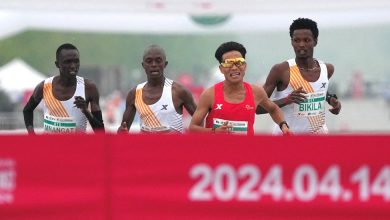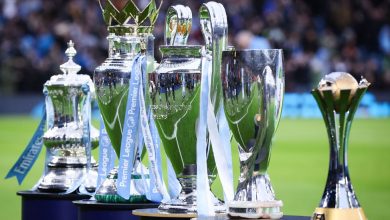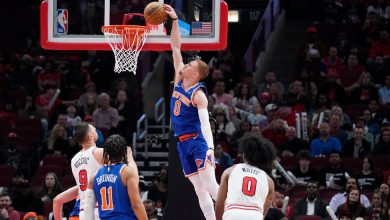What Is LIV Golf? It Depends Who You Ask.

The new Saudi-financed, controversy-trailed LIV Golf series, which is holding its first event this week at an exclusive club north of London, is the talk of golf. Not always, though, in the ways its organizers had hoped.
But what is it? Who is playing it? What’s all the hubbub, and how can you watch it? Here’s what you need to know.
What is LIV Golf?
The new series, bankrolled by Saudi Arabia’s sovereign wealth fund, is billing itself as “an opportunity to reinvigorate golf” through rich paydays, star players and slick marketing. “Golf but louder,” goes one of its slogans.
LIV Golf’s organizers hope to position it as a player-power-focused alternative to the PGA Tour, which has been the highest level of pro golf for nearly a century.
Its critics, which include some of the world’s best players, have labeled it an unseemly money grab.
Who are the players?
The 48 players in the initial LIV Golf event were not exactly a who’s who of golf. There were, of course, big names and former major champions familiar to regular watchers of pro golf: Phil Mickelson, Dustin Johnson, Sergio García, Ian Poulter, Louis Oosthuizen, Graeme McDowell.
But the biggest names in golf stayed away — Tiger Woods said no despite an offer of nearly $1 billion, per Forbes — and there were also players who were no doubt strangers to even deeply committed golf fans: The Americans James Piot, for example, has only ever played in one of golf’s four majors, and missed the cut in it. David Puig is a 20-year-old Spanish amateur. Ratchanon Chantananuwat of Thailand is only 15.
Not everyone is (or, rather, was) a PGA Tour member, either, which was why only 17 members of the LIV Golf Series were suspended by the tour on Thursday.
Why did the PGA Tour suspend them?
The PGA Tour suspended the players because it requires members to request and receive a release to play in events that conflict with those on its schedule.
The punishments were not a surprise: The PGA Tour had clearly signaled months ago that it would take action against any of its players who joined. So moments after the players hit their first shots in the debut event on Thursday, the tour dropped the hammer.
Read More on Formula 1
The 2022 season of the global motorsport, which is enjoying growing popularity and seeking to expand its appeal, is underway.
- Welcome to Miami: The city became the second U.S. city to host a Formula 1 race. The event featured massive parties, fashion shows and world-famous DJs.
- An American Conundrum: Liberty Media, which bought Formula 1 in 2017, wants to increase the sport’s popularity in the United States. Why, then, are there no American-born drivers?
- ‘Drive to Survive’: The Netflix series about Formula 1 has been a hit. But the racer Max Verstappen has some bones to pick.
- Sharing the Spotlight: Drivers in the North America-based IndyCar racing series have welcomed Formula 1’s success. But some fear losing their fans to it.
“In accordance with the PGA Tour’s tournament regulations, the players competing this week without releases are suspended or otherwise no longer eligible to participate in PGA Tour tournament play, including the Presidents Cup,” the tour said in a statement to its members. It said the suspensions also applied to any PGA Tour affiliates — circuits like the lower-tier Korn Ferry Tour, tours in Canada and Latin America and, notably for the older players who joined the LIV series, the PGA Tour Champions series for golfers over 50.
In addition, the PGA Tour said, the players who have resigned their memberships in the tour will be removed from the FedEx Cup points list — essentially ruling them out of the multimillion-dollar season-ending championship series — and are ineligible to use side doors like sponsor’s exemptions or past champion status to get into tour events.
But in a letter explaining the suspensions to other pros, the tour’s commissioner, Jay Monahan, also included a direct warning to any players weighing offers to play in LIV Golf events when the series shifts to the United States later this month.
“The same fate,” Monahan said of the bans, “holds true for any other players who participate in future Saudi Golf League events in violation of our regulations.”
How did the players react?
With a mix of caginess, disappointment and disdain. While the bans were announced almost as soon as the players hit their first shots, a few did not learn about the suspensions until they had completed their rounds.
Phil Mickelson, whose participation has aroused the most interest, refused to comment, and the former U.S. Open champion Graeme McDowell said he had expected the punishment, and had already been in contact with lawyers.
Ian Poulter insisted that he and the others in the field had not done anything wrong, and said he would appeal. “It makes no sense how I’ve played the game of golf for all this time, I’ve had two tour cards and the ability to play all over the world,” Poulter told reporters. “What’s wrong with that?”
Sergio García, the Spanish player who had renounced his tour membership when he joined the LIV Golf Series, essentially said he didn’t care what the PGA Tour did. “I resigned a week and a half ago,” he said, “so whatever the PGA Tour says doesn’t — doesn’t go with me because I’m not a member.”
That led to the following exchange with a reporter:
How much money are we talking about?
The LIV Golf events are the richest tournaments in golf history — this week’s total purse is $25 million, with a $20 million pot for the individual event and $5 million more to split in the team competition. The winner’s share this week is $4 million, and the last-place finisher at each event is guaranteed $120,000.
And that is on top of the appearance fees and signing-on payouts individual players have accepted. Phil Mickelson is being paid a reported $200 million to take part, and Dustin Johnson, the highest-ranked player to sign up-to-date, is said to have been tempted by an offer worth $150 million. Bryson DeChambeau and Patrick Reed, two other top stars expected to compete in the next LIV series event in Oregon, will surely be expecting similar inducements to surrender their PGA Tour careers.
What’s the format?
LIV Golf has set up what are essentially shorter tournaments with smaller fields — three rounds instead of four, and with only 48 players competing instead of the rosters on the PGA Tour, which can be three times as large some weeks — and featuring concurrent individual and team play events.
With the small field, there is no cut midway through the event to lop off the stragglers, and every round starts with a shotgun start, meaning players tee off from each hole on the course simultaneously and then proceed around the course’s layout from there.
The LIV Golf individual competition will feel, in many ways, like a traditional golf event: three rounds, lowest score wins. The team event will see the players drafted by captains into four-man squads (teams with odd names, let’s be honest, like Fireballs and Majesticks) that will contest a separate competition, and for a separate prize pot, each week.
This week’s leaderboard, for example, lists individual scores and team affiliations.
How is that different from the PGA Tour?
With rare exceptions, PGA Tour events generally consist of four-rounds of stroke play, in which players compete against one another to post the lowest score. And while the LIV Golf format might feel unusual for players and viewers, the ultimate goal — circle the 18-hole course in as few shots as possible — is the same.
How many events are there?
Eight this year, but plans to expand to 10 next year and even more in subsequent seasons are being drawn up. The first seven events this year make up what LIV Golf is calling its regular season. The eighth will be the team championship and include a four-day, four-round seeded match-play event.
Those season-ending championships all include their own multimillion-dollar paydays for eligible players.
What’s with that name?
LIV (rhymes with give) Golf chose Roman numerals for its name. If it’s been a while since you studied those in school, LIV translates to 54, which is the number of holes each player will complete in each event’s three-round format, which is one fewer round than a typical PGA Tour workweek, but for a lot more money.
(Before you ask: The most recent N.F.L. championship game was Super Bowl LVI, or 56.)
How can I watch?
Despite its high-profile golfers and its big-money backing, LIV Golf has not yet secured a broadcast rights agreement in the United States — the most lucrative market for televised sports — and will be shown on lesser-watched streaming services in much of the world. (Here’s a full list of non-U.S. options.) That doesn’t mean you can’t watch in the United States, though: This week’s tournament will be available via live streams on LIVGolf.com, YouTube and Facebook.
Normally, television networks would have jumped at the chance to show live sports during slow times on the calendar; witness yet another spring football league being shown on television. But ESPN, CBS, NBC and Amazon are in the first year of a nine-year agreement that has them collectively paying hundreds of millions of dollars annually to the PGA Tour to show tournaments. Those networks may have their fill of golf. They may also not want to court controversy, nor anger their business partner, the PGA Tour.
History suggests, however, that if LIV Golf does prove to be a success, major rights agreements won’t be far behind. With consumers continuing to slowly abandon pay television, live sports is just about the only type of programming that delivers large, and lucrative, audiences anymore. And the streaming services that are luring those consumers away know that live sports is one of the best ways to get new customers, and keep old ones.
So is this just a vanity project for Saudi Arabia?
Not exactly. We asked Ben Hubbard, who covers the Middle East as the Beirut bureau chief for The Times and has written a book on Saudi Arabia’s crown prince, to explain the kingdom’s motivations in a bit more depth. His response:
Saudi Arabia’s backing of the new series is the latest example of the way oil-rich Gulf monarchies use their vast wealth to invest in sports and cultural institutions in hopes of raising their countries’ international profiles and shifting how they are viewed by people in Western countries.
Saudi Arabia’s investments in international sports and culture have accelerated rapidly since 2015, when Crown Prince Mohammed bin Salman began his ascent to become the kingdom’s de facto ruler and spearheaded a massive overhaul aimed at opening up its economy and culture.
For more that a decade, that effort has included governments hosting Formula One races and professional boxing and wrestling matches; opening branches of world-class museums and universities like the Louvre Abu Dhabi and Georgetown University in Qatar; and buying up European soccer clubs. (Saudi Arabia’s sovereign wealth fund, which the crown prince leads as chairman, acquired the Premier League club Newcastle United last year.)
In investing in golf, though, it appears that the Saudis are seeking to win over a different category of sports fan, according to Kristian Coates Ulrichsen, who studies Gulf politics at the Baker Institute for Public Policy at Rice University.
“They are looking for an older, more professional market to try to make inroads to, a wealthier demographic,” Ulrichsen said.
That group includes fans of former President Donald Trump, and perhaps even Trump himself, with whom the crown prince enjoys a close relationship.
Two of the LIV Golf Series events, in fact, will be at Trump-owned courses: the first in late July, at the Trump National Golf Club in Bedminster, N.J., and the season-ending team championship in October, at Trump National Doral Miami.
How has that gone over?
Not always well. One of LIV Golf’s biggest signings, Mickelson, provoked outrage in February when he praised the series as a “once-in-a-lifetime opportunity” even as he called Saudi Arabia’s record on human rights “horrible” and used an expletive to describe the country’s leaders as “scary.” The project’s main architect, the former player Greg Norman, made things worse a few weeks later when he dismissed Saudi Arabia’s murder and dismemberment of Khashoggi by saying, “Look, we’ve all made mistakes.”
Not that the pro golf’s existing power structures, including the PGA Tour, hold the moral high ground.
What’s next?
The tour’s next four events are in the United States, starting with a stop at Pumpkin Ridge Golf Club outside Portland, Ore., from June 30 to July 2, and then tournaments in New Jersey, Boston and Chicago. Trips to Thailand and Saudi Arabia follow, before the season-ending event in Florida. The full schedule is here.
Kevin Draper contributed reporting.



